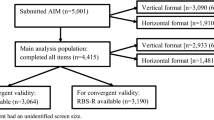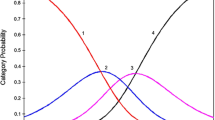Abstract
Objectives
This study reports the development of the AUT-EZ-ME, a new diagnostic instrument in order to quickly, reliable, and valid identify and differentiate children with autism aged 4–18 years.
Methods
A total of 216 parents of children age 4 to 18 years participated in this study and were divided into three groups: children with autism, children without any diagnosis, and children with other diagnosis. The participants were asked to complete the AUT-EZ-ME which could be administered online. The AUT-EZ-ME is a 36-item parent report questionnaire based on the empathizing-systemizing theory. The questionnaire consists of a series of descriptive statements designed to assess three main features of autism and the eleven associated areas as shown in previous research: social skills, attention switching, attention to detail, communication, imagination, recognition of emotions, sharing of emotional states, perspective taking, narrow interests, repetitive behavior, and resistance to change or need for sameness.
Results
A very clear differentiation was found between children with autism and the typical group and the other diagnosis groups using the AUT-EZ-ME. Furthermore, we found a good internal consistency of the AUT-EZ-ME and its belonging subscales.
Conclusions
The AUT-EZ-ME is found to be a reliable and valid diagnostic tool for the identification of children with autism. The AUT-EZ-ME showed satisfactory internal consistency and high sensitivity together with low specificity when a cut-off score is set at 26.
Similar content being viewed by others
Data Availability
The datasets/literature during and analyzed during the current study available from the corresponding author on reasonable request.
References
American Psychiatric Association. (2013). DSM 5 diagnostic and statistical manual of mental disorders (5th ed.). American Psychiatric Association.
Asperger, H. (1944). Die autistisehen Psychopathen im Kindesalter. Archiv für Psychiatrie und Nervenkrankheit, 117, 76–136.
Auyeung, B., Baron-Cohen, S., Wheelwright, S., & Allison, C. (2007). The autism spectrum quotient: Children’s version (AQ-Child). Journal of Autism and Developmental Disorders, 38, 1230–1240.
Auyeung, B., Wheelwright, S., Allison, C., Atkinson, M., Samarawickrema, N., & Baron-Cohen, S. (2009). The children’s empathy quotient and systemizing quotient: Sex differences in typical development and in autism spectrum conditions. Journal of Autism and Developmental Disorders, 39(11), 1509–1521.
Auyeung, B., Allison, C., Wheelwright, S., & Baron-Cohen, S. (2012). Brief report: Development of the adolescent empathy and systemizing quotients. Journal of Autism and Developmental Disorders, 42(10), 2225–2235.
Baron-Cohen, S. (1995). Mindblindness: An essay on autism and theory of mind. MIT Press.
Baron-Cohen, S. (2002). The extreme male brain theory of autism. Trends in Cognitive Sciences, 6, 248–254.
Baron-Cohen, S. (2003). The essential difference: Male and female brains and the truth about autism. Basic Books.
Baron-Cohen, S. (2009). Autism: The empathizing-systemizing (E-S) theory. The Year in Cognitive Neuroscience, 2009(1156), 68–80. https://doi.org/10.1111/j.1749-6632.2009.04467.x
Baron-Cohen, S., Hoekstra, R., Knickmeyer, R., & Wheelwright, S. (2006). The autism-spectrum quotient (AQ)—adolescent version. Journal of Autism and Developmental Disorders, 36, 343–350.
Baron-Cohen, S., Wheelwright, S., Skinner, R., Martin, J., & Clubley, E. (2001). The autism spectrum quotient (AQ): Evidence from Asperger syndrome/high functioning autism, males and females, scientists and mathematicians. Journal of Autism and Developmental Disorders, 31, 5–17.
Baron-Cohen, S., & Wheelwright, S. (2004). The empathy quotient (EQ). An investigation of adults with Asperger syndrome or high functioning autism, and normal sex differences. Journal of Autism and Developmental Disorders, 34, 163–175.
Baron-Cohen, S., & Lombardo, M. (2017). Autism and talent: The cognitive and neural basis of systemizing. Translational Research Dialogues in Clinical Neuroscience, 19(4), 345–353.
Decety, J., & Meyer, M. (2008). From emotion resonance to empathic understanding: A social developmental neuroscience account. Developmental Psychopathology, 20, 1053–1080.
Demurie, E., De Corel, M., & Roeyers, H. (2011). Empathic accuracy in adolescents with autism spectrum disorders and adolescents with attention-deficit/hyperactivity disorder. Research in Autism Spectrum Disorders, 5, 126–134.
Ellis, H., & Gunter, H. (1999). Asperger syndrome: A simple matter of white matter? Trends in Cognitive Sciences, 3, 192–200.
Gillberg, C. (1992). Subgroups in autism: Are there behavioral phenotypes typical of underlying medical conditions? Journal of Intellect Disability Research, 36, 201–214.
Groen, Y., Fuermaier, A., Den Heijer, A., Tucha, O., & Althaus, M. (2015). The empathy and systemizing quotient: The psychometric properties of the Dutch version and a review of the cross-cultural stability. Journal of Autism and Developmental Disorders, 45, 2848–2864.
Hobson, J. A., Harris, R., García-Pérez, R., & Hobson, R. P. (2009). Anticipatory concern: a study in autism. Developmental Science, 12(2), 249–63.
Johnson, S., Filliter, J., & Murphy, R. (2009). Discrepancies between self- and parent-perceptions of autistic traits and empathy in high functioning children and adolescents on the autism spectrum. Journal of Autism and Developmental Disorders, 39, 1706–1714.
Kanner, L. (1943). Autistic disturbances of affective contact. Nervous Child, 2, 217–250.
Van der Zee, E., & Derksen, J. J. L. (2017). Identifying autism through empathizing and systemizing abilities. Social Sciences, 6(4), 124–130.
Van der Zee, E., & Derksen, J. (2019). Reconsidering empathy deficits in children and adolescents with autism. Journal of developmental and physical disabilities, 32, 23–39.
van der Zee, E., & Derksen, J. (2021). The power of systemizing in autism. Child Psychiatry & Human Development, 52, https://doi.org/10.1007/s10578-020-01014-4
Wheelwright, S., Baron-Cohen, S., Goldenfeld, N., Delaney, J., Fine, D., Smith, R., Weil, L., & Wakabayashi, A. (2006). Predicting autism spectrum quotient (AQ) from the systemizing quotient-revised (SQ-R) and empathy quotient (EQ). Brain Research, 24(079(1)), 47–56.
Author information
Authors and Affiliations
Contributions
JD collaborated in the writing and editing of the final manuscript. EZ designed and executed the study, analyzed the data, and wrote the paper. Both authors read and approved the final manuscript.
Corresponding author
Ethics declarations
Ethics Approval
All procedures performed in studies involving human participants were in accordance with the ethical standards of the institutional and/or national research committee and with the 1964 Helsinki declaration and its later amendments or comparable ethical standards. This article does not contain any studies with animals performed by any of the authors.
Consent to Participate
Informed consent was obtained from all individual participants in the study.
Consent for Publication
Not applicable.
Competing Interests
The authors declare no competing interests.
Additional information
Publisher's Note
Springer Nature remains neutral with regard to jurisdictional claims in published maps and institutional affiliations.
Supplementary Information
Below is the link to the electronic supplementary material.
Appendix
Appendix
AUT-EZ-ME
-
1.
S/he often notices small sounds when others do not.
-
2.
In a social group, s/he can easily keep track of several different people’s conversations.
-
3.
When s/he is reading a story, s/he finds it difficult to work out the characters’ intentions or feelings.
-
4.
S/he finds it hard to make new friends.
-
5.
S/he does not know how to keep a conversation going with his/her peers.
-
6.
S/he usually concentrates more on the whole picture, rather than the small details.
-
7.
S/he finds it easy to go back and forth between different activities.
-
8.
S/he finds it easy to work out what someone is thinking or feeling just by looking at their face.
-
9.
S/he is good at social chit-chat.
-
10.
When s/he was in preschool, she used to enjoy playing games involving pretending.
-
11.
My child likes to take care of others.
-
12.
My child often doesn’t understand why some things upset other people so much.
-
13.
My child has trouble forming friendships.
-
14.
My child has one or two close friends, as well as several other friends.
-
15.
My child shows concern when others are upset.
-
16.
My child can easily tell when another person wants to enter into conversation with them.
-
17.
My child would worry about how another child would feel if they weren’t invited to a party.
-
18.
My child likes to help new children integrate in class.
-
19.
My child gets upset at seeing others crying or in pain.
-
20.
My child listens to others’ opinions, even when different from their own.
-
21.
My child is often rude or impolite without realizing it.
-
22.
My child can adequately react to another child that’s crying.
-
23.
My child makes eye contact in a conversation.
-
24.
My child uses a dressing-up box when playing.
-
25.
My child understands what other individuals mean when they are not using words.
-
26.
My child does not mind if things in the house are not in their proper place.
-
27.
My child is interested in the different members of a specific animal category.
-
28.
My child would not notice if something in the house had been moved or changed.
-
29.
My child is interested in different types of vehicles.
-
30.
My child likes to collect things.
-
31.
My child gets annoyed when things aren’t done on time.
-
32.
My child remembers large amounts of information about a topic that interests them.
-
33.
My child is not bothered about knowing the exact timings of the day’s plans.
-
34.
My child tends to repeat certain remarkable behavior every day.
-
35.
My child does not spend large amounts of time lining things up in a particular order.
-
36.
My child likes to spend time mastering particular aspects of their favorite activities.
Rights and permissions
About this article
Cite this article
van der Zee, E., Derksen, J.J.L. Development and Validation of a New Autism Questionnaire: AUT-EZ-ME. Adv Neurodev Disord 6, 29–35 (2022). https://doi.org/10.1007/s41252-021-00228-4
Accepted:
Published:
Issue Date:
DOI: https://doi.org/10.1007/s41252-021-00228-4




